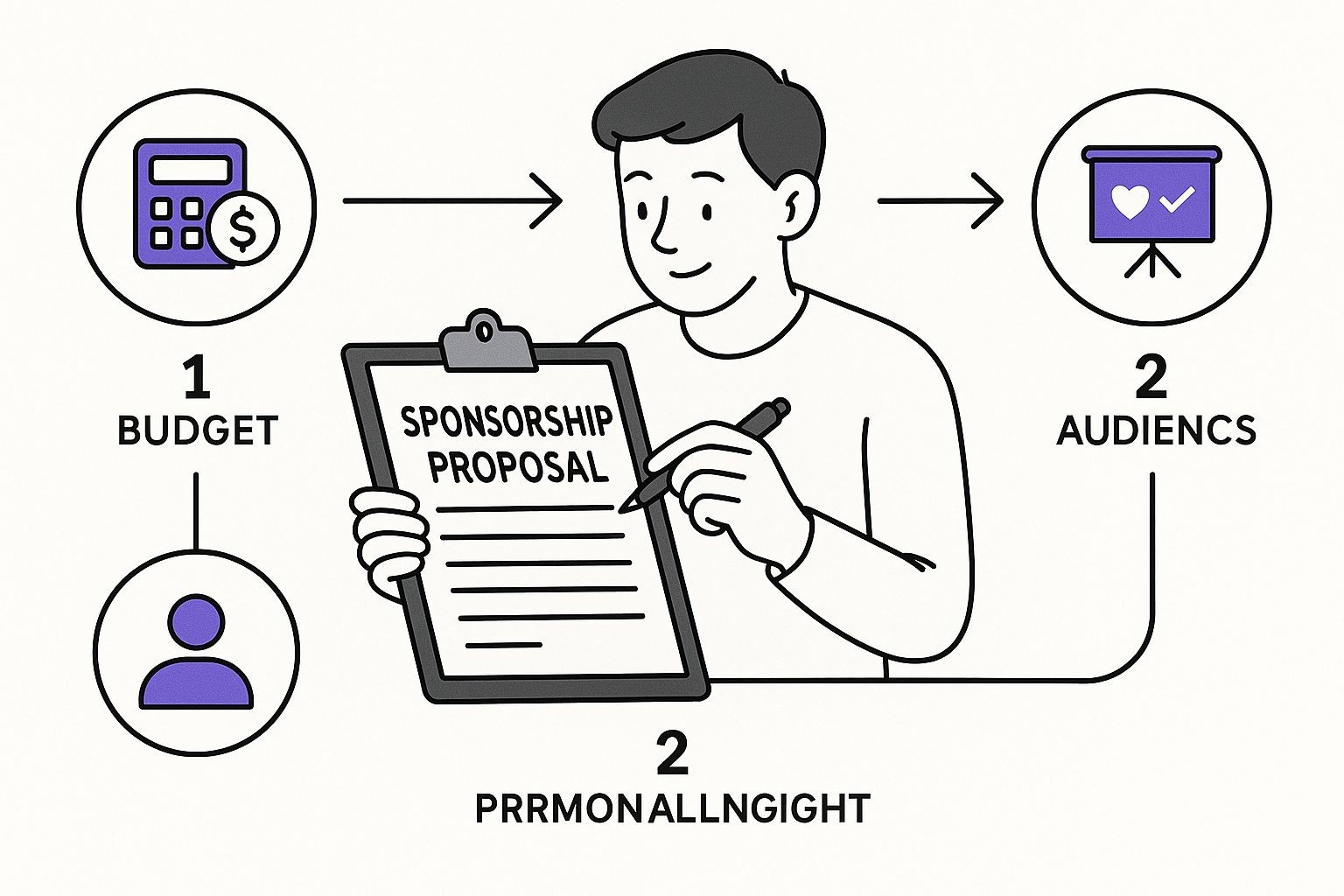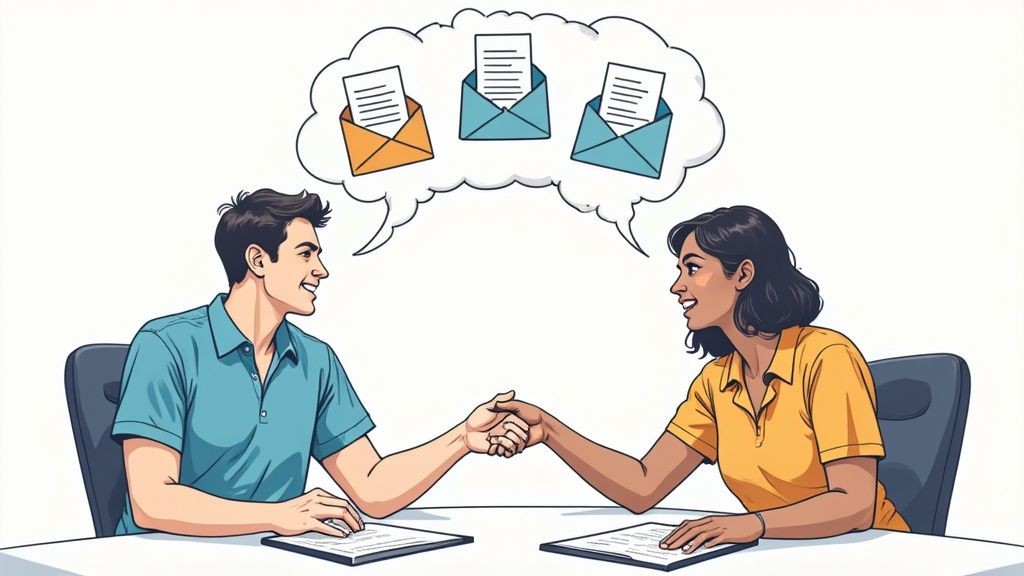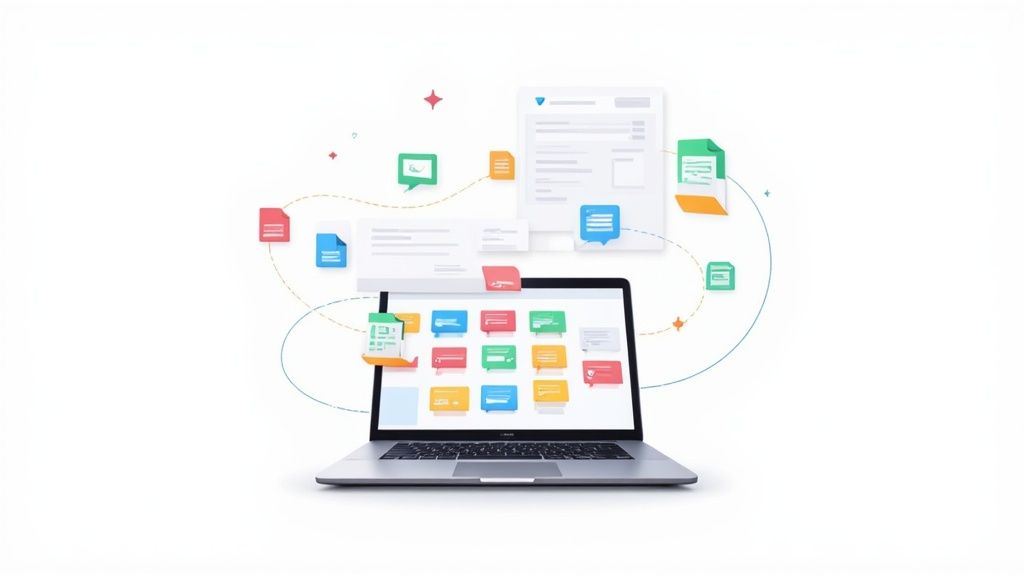Securing event sponsorships isn't just about asking for a check. It’s about building a genuine partnership that delivers real value to both sides. To be successful, you have to get inside a sponsor's head. You need to understand their goals - are they trying to break into a new market? Polish their brand image? - and then show them exactly how your event is the key to making that happen.
What Modern Event Sponsorship Really Looks Like
If you're still thinking in terms of just plastering a sponsor's logo on a banner, it's time for a major rethink. The sponsorship game has gotten way more sophisticated. Companies are incredibly strategic with their marketing budgets and they absolutely expect to see a tangible return on their investment.
They're not making a donation. They're partnering with you to hit specific business objectives. Grasping this fundamental shift is the first real step to figuring out how to land sponsors for your event. Brands are hungry for authentic connections with their target audience, and your event can be the bridge that gets them there.
Moving Beyond Simple Brand Exposure
Sure, visibility still matters, but modern sponsors want so much more. They're hunting for genuine engagement, solid lead generation, and opportunities to build real brand affinity. This means you’ve got to get creative with the value you're bringing to the table.
So, what do they actually want?
- Access to a Niche Audience: Think about it. Your attendees are a highly targeted group that a sponsor might burn through cash trying to reach with traditional ads.
- Positive Brand Association: By backing a respected event, a company gets to borrow some of your brand's credibility. It’s a powerful way to boost their own image.
- Data and Insights: Sponsors need hard numbers to justify their spending. This means you need to be ready to provide audience demographics, engagement metrics, and solid post-event analytics.
- Lead Generation Opportunities: Whether it's through a booth on the floor, a coveted speaking slot, or a savvy digital promotion, sponsors want direct lines to potential customers.
The market for this kind of partnership is massive and it's only getting bigger. Just look at the global sports sponsorship market - it was valued at around USD 60.17 billion in 2024 and is expected to more than double by 2033. That's a staggering amount of growth, and it proves how seriously brands are investing in events to capture people's attention. You can dig into more of the data in the full Straits Research report on the sports sponsorship market.
The biggest mistake I see event organizers make is focusing on what they need. You have to flip the script. Focus entirely on what the potential sponsor needs. Your proposal has to be the solution to their marketing problems, not just your budget problems.
When you position your event as a strategic marketing opportunity instead of just a plea for funding, you completely change the conversation. You stop being a cost and start being a partner in their success. That makes your proposal infinitely more compelling and sets the stage for a strong, long-term relationship.
How to Find and Vet Potential Sponsors
The days of mass-emailing a generic sponsorship request and just hoping for the best are long gone. Let's be honest, they never really worked anyway.
Real success in landing event sponsorships comes from smart, targeted prospecting. It all starts with building a curated list of potential partners whose values, audience, and marketing goals genuinely click with your event.
This initial research phase is absolutely non-negotiable. If you skip it, your pitches will feel impersonal and completely miss the mark, wasting both your time and theirs. The goal is to shift from a "spray and pray" mindset to a strategic, almost surgical approach where every single outreach is backed by solid reasoning.
Start With Your Audience
Before you even think about specific company names, look at the people who actually attend your event. Who are they? What brands do they already love and trust? The most powerful partnerships happen when a sponsor is already a natural part of your audience's world.
Kickstart your brainstorming by asking yourself a few key questions:
- Who is already sponsoring similar events? Take a look at conferences, festivals, or webinars in your niche. Who are their headline sponsors? This is your most direct source of qualified leads.
- Which companies are your speakers or key attendees connected to? A warm introduction through a mutual connection is pure gold.
- What tools, products, or services does your target audience use daily? Think about the software they can't live without, the gear they use, or the financial services they rely on.
This audience-first approach ensures that any partnership you propose will feel authentic and natural - which is exactly what modern brands are looking for.
Dig Deeper Than the Homepage
Once you have a preliminary list, it’s time to vet each prospect. You need to understand their current marketing strategy, not just what their "About Us" page says. Look for recent press releases, social media campaigns, and interviews with their executives to get a feel for what they truly care about right now.
Your homework is what separates a compelling proposal from a generic one. A pitch that references a sponsor's recent product launch or aligns with their latest social responsibility campaign shows you've done the work and are serious about a real partnership.
The sponsorship world is also changing. Brands are consolidating their portfolios, choosing to invest more money into fewer, higher-impact deals. Many are also placing a heavy emphasis on environmental, social, and governance (ESG) commitments, making a shared-values connection more critical than ever.
As you research, look for these cues to tailor your pitch. For a deeper dive into how things are shifting, check out the latest insights on global sponsorship trends.
Ultimately, this detailed vetting process transforms your outreach. You’re no longer just asking for money. You're presenting a well-researched, strategic opportunity that solves a problem for them, making a "yes" far more likely.
Craft a Sponsorship Proposal That Actually Gets a "Yes"
Think of your sponsorship proposal as more than just a request for cash - it’s your single most important sales tool. A generic, copy-paste deck just won't fly. To really grab a potential sponsor's attention, your proposal needs to tell a compelling story about your event and make the return on their investment impossible to ignore.
This is where you bridge the gap between your audience and their marketing goals. The document has to be professional, packed with real data, and genuinely persuasive. It's about shifting their mindset from "giving you money" to "investing in a powerful partnership." A killer proposal makes it incredibly easy for a busy decision-maker to say "yes."
This visual really sums up the key pieces you need to build a winning proposal, from knowing your audience inside and out to defining crystal-clear benefits.

As you can see, every element - from attendee demographics to the specific perks you're offering - has to work together. They all combine to build an airtight case for why they should invest in your event.
Structure Clear Sponsorship Tiers
Vague partnership ideas lead to confusion, and confused people don't write checks. The solution? Structure your offerings into clear, distinct sponsorship tiers. This approach lets companies quickly see which level aligns with their budget and marketing objectives.
A good starting point is to create three or four levels, like Platinum, Gold, and Silver. Each tier should build on the last, offering progressively more value and visibility. Your top-tier package, for instance, might include a keynote speaking slot and exclusive branding, while the entry-level tier could focus on logo placement and social media shout-outs.
To give you a better idea, here's a look at how you could structure your own sponsorship packages.
Example Sponsorship Tier Structure
This table breaks down a common sponsorship tier structure. Use it as a starting point to think about the different levels of value you can offer potential partners.
| Tier Level | Example Price Range | Key Benefits Offered |
|---|---|---|
| Platinum Partner | $10,000+ | Headline branding ("Event Presented By..."), main stage speaking slot, exclusive email blast to attendees, prominent logo on all materials. |
| Gold Sponsor | $5,000 - $9,999 | Branded session or workshop, dedicated booth in a high-traffic area, logo on event website and key signage, social media spotlight. |
| Silver Sponsor | $1,500 - $4,999 | Logo placement on the event website and program, inclusion in a "thank you" email, shared signage recognition. |
This kind of clear structure empowers sponsors to quickly assess the value and figure out exactly where they fit.
Go Beyond Logo Placement with Creative Activations
Let's be honest: modern sponsors want more than just their logo slapped on a banner. They're looking for active engagement and memorable experiences. Your proposal needs to spark their imagination with creative activation ideas that let them interact directly with your attendees.
Think about what unique experiences you can create.
- A Branded Lounge: Offer a top-tier sponsor an exclusive "recharge lounge" with comfy seating and charging stations. It's a lifesaver for attendees and creates amazing brand association.
- Interactive Contests: Propose a social media contest or a fun scavenger hunt co-hosted with a sponsor to drive buzz and engagement.
- Product Demos: Give a tech sponsor a dedicated space to show off their latest product to a captive and interested audience.
These kinds of activations provide tangible, memorable value that a simple logo placement just can't match.
The best proposals I've ever seen showed a real understanding of the sponsor's brand. They didn't just list generic options; they suggested a custom activation that perfectly matched a current marketing campaign or product launch. It showed they did their homework.
Don't forget that the look and feel of your proposal matter just as much as the words. Use professional branding, high-quality images, and clear charts to back up your claims. For example, featuring sponsor logos prominently on your event landing page from day one gives them valuable, early exposure. You can dive deeper into optimizing your page with our guide on creating an effective event landing page.
When you're done, your proposal should leave them with zero doubt that partnering with your event is one of the smartest business decisions they'll make all year.
Mastering Your Outreach and Follow-Up Game
Look, a brilliant proposal is worthless if it just sits in the wrong inbox or gets buried under a mountain of other emails. This is where all your hard work pays off - or doesn't. Effective outreach is how you bring your research and your proposal to life. It's the moment you actually connect with a real person, and your approach can make or break the entire deal.
Your goal here is to cut through the noise with a personal, professional touch. A generic "Dear Sir/Madam" email is a one-way ticket to the trash folder. We all know it. Instead, jump on a professional network like LinkedIn to pinpoint the right contact. You're probably looking for a Marketing Director, Brand Manager, or maybe even a dedicated Sponsorship Coordinator.
Once you’ve found your person, keep that first email short, sharp, and focused on their brand's needs, not just yours.
The Art of the Follow-Up
Here's a little secret from the trenches: the real magic isn't in the first email. It's in the follow-up.
Most decision-makers are drowning in emails. Your first message might have been perfect, but it got buried. It happens. Following up shows you're professional, organized, and genuinely interested in a partnership.
The key is to walk that fine line between persistent and pestering. Here’s a simple timeline I've found works well and doesn't feel pushy:
- First Follow-Up (3-5 business days later): Send a brief, polite email. The goal is just to bump your original message back to the top of their inbox.
- Second Follow-Up (a week after the first): Now, try a different angle. Share an exciting update about your event - maybe a new speaker signed on or you hit a key milestone. This adds fresh value.
- Final Follow-Up (another week later): One last friendly check-in. Let them know you're still keen to connect but will respect their time if now isn't right. You'd be surprised how often this "last chance" email gets a reply.
Warming Up Your Contacts
Before you even think about hitting "send" on that first email, try to warm up the contact.
Go engage with their company’s content on social media. Better yet, see if you have a mutual connection who can make a warm introduction. This one move can dramatically boost your response rate, turning a completely cold email into a familiar one.
A personalized, thoughtful approach is everything. I once secured a major sponsor because my outreach email mentioned a recent award their company won. It showed I was paying attention and wasn't just blasting out a generic template. That small detail started the entire conversation.
The whole world of sponsorship is getting more and more professional. It’s not just about slapping a logo on a banner anymore. Consumer trust is a massive driver - in fact, 81% of consumers worldwide say they have faith in sponsorships.
That trust is exactly why 47% of global brands now have dedicated teams managing these deals. They treat sponsorships as strategic investments, not just another ad buy. You can dig into the numbers in the Business Research Insights report on the sports sponsorship market.
What does this mean for you? It means every piece of your communication, from that first email to the final negotiation, needs to be razor-sharp.
A well-crafted event media release, for example, can be a fantastic tool to share with potential sponsors to prove your event's credibility. If you need some help, check out our guide on how to write an effective event media release.
Ultimately, a masterful outreach strategy shows them you're a serious partner worth investing in.
Negotiating Terms and Activating the Partnership

Getting that initial "yes" from a potential sponsor is an amazing feeling, but it’s not the finish line. Not even close. Now comes the part where a good deal transforms into a great one: negotiation and activation. This is where you hammer out the final details and then, just as critically, bring the whole partnership to life.
A lot of event organizers trip up right here. They're either too rigid in their demands or they cave too easily. The trick is to stop thinking of it as a confrontation. It's a collaboration. You want to land on an agreement where both you and your sponsor feel like you've genuinely won.
Focusing the Negotiation on Mutual Value
When you start talking specifics, it’s so easy to get dragged into a tug-of-war over price. Don't let that happen. Your job is to constantly bring the conversation back to the value they're getting.
If a sponsor balks at a price, your first move shouldn't be to offer a discount. Instead, remind them what they’re buying: direct access to their ideal customer, powerful brand alignment, and real, tangible leads.
Of course, sometimes the budget is just the budget. This is where you get to be creative.
- Offer Alternative Value: Can't lower the price? What if you offered them an exclusive pre-event email blast to your attendee list? That's high-value for them, low-cost for you.
- Explore In-Kind Contributions: Could they provide their product for a VIP giveaway or offer their software to help run your event? This can supplement a smaller cash investment and reduce your own costs.
- Customize the Package: Just ask them what they care about most. I’ve seen sponsors who would rather have a 15-minute speaking slot than a massive booth. That's an easy swap that makes them feel heard.
A successful negotiation isn't about one side winning; it's about crafting an agreement that genuinely excites both parties. Always ask, "What are we missing?" This simple question can uncover a sponsor's true priorities and unlock creative solutions that go beyond your standard packages.
From Agreement to Flawless Activation
Once the ink is dry on the contract, your focus has to pivot immediately to activation. This is the nitty-gritty of delivering on every single promise you made. A smooth, professional activation is what turns a one-time sponsor into a recurring partner.
First thing’s first: create a detailed activation plan. This is your bible. It should outline every deliverable, every key deadline, and who on your team is responsible for what. Share this document with your sponsor and - this is crucial - give them a single, dedicated point of contact. No one wants to be bounced between three different people to get a simple question answered.
Next, get ahead of their needs. Don't wait for them to ask for logo specs or booth setup times. Send everything they need proactively. Over-communicating is your best friend here. Tell them what you need from them and when you need it, but make it clear that you're managing the entire process.
Your goal is to make their participation as effortless as possible, so they can focus on their goals for the event. Flawless execution is how you prove their investment was a smart one.
Proving ROI and Building Long-Term Relationships
The event might be over, but your work isn't done - not by a long shot. In fact, what you do now is what separates a one-time sponsorship from a lasting partnership. This is your chance to stop talking about potential and start showing them exactly what their investment delivered.
A thoughtful, data-backed follow-up is the secret sauce. Sponsors are under pressure to justify every dollar of their marketing spend. Your job is to hand them a report that makes them look like a genius for backing your event.
Crafting a Powerful Post-Event Report
Don’t just send a quick thank-you email and call it a day. You need to build a professional post-event impact report that tells a compelling story with cold, hard numbers. This document is your proof of performance, your final deliverable, and the foundation for your next proposal.
Think of it as the highlight reel of your partnership's success. Your report should be packed with value, including things like:
- Key Performance Metrics: Lead with the data. We're talking final attendance numbers, social media reach and engagement stats, website traffic spikes during the promo period, and email open rates for sponsor-mentioned blasts.
- Visual Evidence: Photos and videos are your best friends here. Show them pictures of their booth swarming with attendees, their logo splashed across a main stage, or one of their speakers captivating the audience.
- Audience Testimonials: Did an attendee rave about a sponsor's booth or contribution? Get that quote in there! Authentic, third-party validation is worth its weight in gold.
- Media Mentions: Pull together any press clippings, blog posts, or shout-outs from influencers that featured the sponsor. Show them the buzz they helped create.
This kind of comprehensive report gives your sponsors the exact ammunition they need to prove the event's value to their own bosses.
The whole point of a post-event report isn't just to say 'thanks.' It's to prove undeniable ROI. When a sponsor can slide your report across their manager's desk and show precisely what their investment achieved, you've made their job easier and your renewal practically a given.
Leveraging Unique Engagement Data
This is also where modern event tools can give you a serious edge. Take our service, for example. It can provide specific engagement data that sponsors absolutely love. You can literally show them how many people added the event to their personal calendar directly from the sponsor's unique tracking link.
That’s not some fluffy vanity metric; it’s a direct measurement of intent and engagement driven by their specific efforts. This kind of granular data takes your report from "good" to "unforgettable." If you're curious about diving deeper into tracking these kinds of results, we've put together a full guide on measuring event marketing ROI.
When you deliver a killer report, keep the lines of communication open, and consistently prove your value, you completely change the conversation. It’s no longer about if they should sponsor your next event, but about how much bigger they can go next time.
Got Sponsorship Questions? We've Got Answers
Stepping into the world of event sponsorships can feel a bit like navigating a maze. A lot of questions pop up, especially when you're just getting started. Let's tackle some of the most common ones I hear from event organizers to help you build your sponsorship strategy with confidence.
How Far in Advance Should I Start Looking for Sponsors?
The short answer? Way earlier than you think.
Ideally, you should kick off your sponsorship outreach 6 to 12 months before your event. I know, that sounds like a huge runway, but there are some really good reasons for it. This timeline gives you the breathing room you need to do proper research, build real relationships (not just send cold emails), and get through the often slow-moving corporate approval process.
More importantly, most big brands lock in their marketing and sponsorship budgets a full year in advance. If you show up late to the party, the money's already gone. Getting on their radar early means you’re part of the conversation when those critical budget decisions are being made.
What’s the Deal with In-Kind Sponsorships?
An in-kind sponsorship is simply when a company gives you goods or services instead of a check. Think of a local brewery providing all the beer for your happy hour, or a tech company loaning you the A/V equipment for your main stage.
Should you offer them? Absolutely! In-kind deals are a game-changer for your budget, as they can slash your event expenses. They're also an easier "yes" for companies that might be tight on cash but have plenty of products or services to share.
Just be sure to frame it correctly in your proposal. Show the clear monetary value of their contribution - what it would have cost you to buy that beer or rent that equipment - so they understand the real value they're bringing to the table.
How Do I Figure Out My Sponsorship Prices?
Pricing your packages is more of an art than a science, but it boils down to a few key things.
First, you have to know your numbers. Calculate your total event costs to figure out the bare minimum you need to raise to break even. Next, do a little market research. See what similar events in your industry are charging for sponsorships to get a feel for the going rate.
Finally, you need to assign a real value to the benefits you’re offering in each package. This isn't just guesswork. Think about tangible assets like the number of projected media impressions and, most importantly, direct access to your specific audience.
Here's a pro tip: Don't be afraid to go off-menu for a potentially amazing sponsor. If a great-fit company loves your event but doesn't see a package that's quite right, offer to build something custom with them. This kind of flexibility shows you're thinking like a true partner, and it often leads to the biggest and best deals.
At Add to Calendar PRO, we know that proving value is everything. Vague promises don't cut it anymore. Our service gives you clear, measurable data, like tracking unique "add to calendar" link clicks, so you can show sponsors tangible proof of the engagement their partnership generated. See how you can prove ROI by checking out what we offer.



